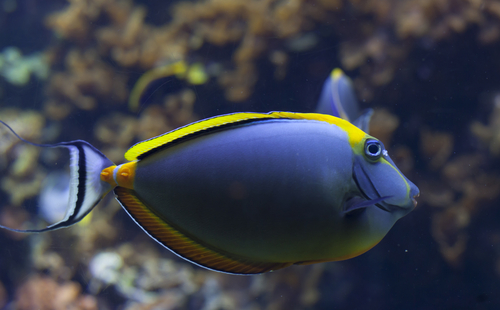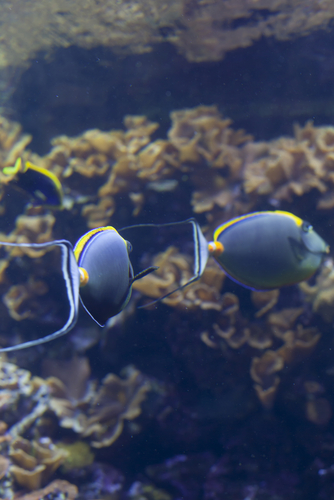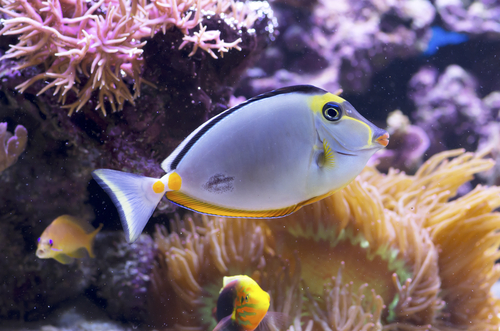Blonde Naso Tang: Care, Acclimation, Where To Purchase & More
Posted by Miles Harrison on 01/05/2023
If you own a large saltwater aquarium and are looking to add a unique-looking fish to your saltwater aquarium, look no further than the Blonde Naso Tang. This fish is sought after for its appearance, but you’ll want to make sure you’re well-versed in its care requirements before taking the leap and purchasing this species.
Luckily, we’ll cover it all in this blog post. We’re going to discuss tank size recommendations, where to purchase this fish, potential diseases, tank mate options, and much more.
Species Summary
The Blonde Naso Tang, also known as the Orange-spine Unicornfish (scientific name: Naso elegans), is an attractive saltwater aquarium fish native to the reefs of the Indian Ocean. They have a relatively wide distribution, and can be found in Indonesia and as far south as the coast of South Africa. They belong to the Acanthuridae family, which includes surgeonfish, tangs, and unicorn fish.
First classified by the German explorer, Eduard Ruppell in 1829, species in the Naso genus are known for their unicorn-like spears that exist on their heads. However, the Blonde Naso Tang is unique in that it does not have this protruding horn.
Emerging in popularity in the late 1980s, this fish was briefly known as the Madonna tang, a name which was based on the dorsal fin coloration resembling that of pop singer Madonna's hair.

Appearance
Blonde Naso Tangs are attractive-looking fish, their orange lips and black noses are highlighted in a distinct yellow, and their fins have a unique "sunburst" coloration.
Their pectoral fins are translucent-yellow, and their anal fins transition in color from yellow to orange. Their dorsal fins also have a bright yellow color, and their tail fins are visually separated from their bodies by blotches of orange and white.
Similar to other Naso species, these fish can change color rather quickly. Do not be surprised if you notice a Naso tang appearing almost black at times. Their mood and environment are contributing factors to changes in coloration.
Juveniles will typically have less vibrant colors, and mature males will often develop unique-looking streamers on the corners of their caudal fins.

Blonde Naso (Naso Elegans) vs Regular Naso (Naso Lituratus)
Naso Literatus is an incredibly similar looking fish but is instead found in the Western Pacific. The Blonde Naso (Naso Elegans) is found in the Indian Ocean.
Look at the dorsal and tail fins to spot the difference. Naso Lituratus have predominantly black and gray colors, while Naso Elegans have predominantly yellow dorsal fins with some shades of black.

Size
Blonde Naso Tangs are large fish, and adults 4-5 years in age can reach up to 18 inches in length.
Juvenile fish are often sold between 4-6 inches in size. Inquiring about the age of your fish when purchasing can help with estimating their growth rate.
While juveniles live longer, older Blonde Naso Tangs typically do better at transitioning to a new aquarium environment.
Blonde Naso Tang Care
When given the proper environment, Blonde Naso Tangs can live a healthy life in a saltwater aquarium. If you’re considering adding one of these fish to your tank, you’ll want to know all about their care requirements.
Blonde Naso Tangs (scientific name: Naso Elegans) are found throughout the reefs of the Indo-Pacific, and you’ll want to re-create these environments as closely as possible in your aquarium.
Lifespan
Blonde Naso Tangs are a long-lived species, in the wild, these fish can live for up to 30 years. While there are few reports of these fish living this long in captivity, given the proper environment, these fish can easily live for over 10 years for many hobbyists.
Tank Size
We recommend having an aquarium that’s at least 200 gallons in size if you plan on housing a Blonde Naso.
Many beginner aquarists make the mistake of purchasing juvenile fish without realizing that it will take years for a fish to grow to its full length. Knowing a fish's adult size and required tank size before purchasing can save you from having to re-home or sell your fish.
Acclimation
Blonde Naso Tangs can be easily acclimated to an aquarium like most other fish. To begin the acclimation process, float the bag containing the fish in the aquarium for about 15 minutes to equalize the temperature. Then, slowly introduce the fish to the aquarium water by partially rolling down the top of the bag and adding a quarter of the bag's volume with tank water.
Repeat this process four more times, waiting 15 minutes in between each addition. By the end of this process, the Blonde Naso Tang should be comfortably acclimated to its new home. It's worth noting that while some aquarists prefer drip acclimation, Blonde Naso Tangs are generally hardy and should adapt well using either method.
Water Conditions
Blonde Naso Tangs are found at depths of up to 100 feet below the surface. These tropical waters are what you’ll want to recreate in your saltwater aquarium.
Aim for the following if you plan on keeping a Blonde Naso Tang:
Specific Gravity: 1.020-1.025
Temperature Range: 72°F-78°F
KH: 8-12 dKH
pH: 8.1-8.4
You’ll want to maintain these conditions for the duration of your Blonde Naso Tang's life. Testing water conditions with reliable test kits is essential in ensuring the health of this species.
Tank Setup
After you’ve purchased an appropriately sized aquarium, you may want to fill it with interesting pieces of live rock, or perhaps a frag rack if you plan on growing different species of coral. Blonde Naso Tangs will appreciate plenty of caves and small caverns to hang out in, but it’s important to always keep plenty of open space in the tank for a Blonde Naso Tang. These fish are active swimmers, and they’ll often be investigating new potential food sources.
Reef hobbyists will be pleased to know that these fish are considered reef-safe, opening up plenty of interesting coral additions, such as torches or brain corals.
A tight-fitting lid is a must for keeping these fish. Although they’re not known as frequent jumpers, any fish is capable of jumping out of the tank, especially if they get spooked by a loud noise or vibration. These fish also prefer plenty of flow, so you'll want to add additional powerheads to create a strong current.
Common Diseases
Blonde Naso Tangs are susceptible to many of the diseases that affect saltwater aquarium fish, but two of the most common are ick and marine velvet disease. Blonde Naso Tangs do not have a slime coat, making them slightly more susceptible to these diseases.
If you notice your fish breathing heavily, erratic swimming behavior, loss of appetite, or the fish is covered in small dots, you likely have either marine velvet disease or ick.
You can differentiate these diseases by examining the small dots on the affected fish, if there are far too many dots to count, it’s marine velvet disease. Marine velvet disease spots look closer to a fine powder, rather than the grain-sized dots seen with ick.
If you’ve determined you have marine velvet disease, you’ll need to immediately transfer your affected fish to an established quarantine tank. Once inside the established tank, you can treat the fish with Chloroquine phosphate or Ruby Reef Rally . After about 6 weeks, the disease should begin to die off, and your fish will be ready to be transferred back into your display tank.
If the small dots covering your fish are a bit larger, it’s most likely ick, and treatment typically involves Hyposalinity. You’ll want to raise your specific gravity levels to 1.010-1.013, these levels are lethal to saltwater ich, but your fish can tolerate the increase. Once your battle with Ick has come to an end (typically around day 7 of treatment), you can return your specific gravity levels to their previous range.
Prevention is always the best form of treatment. Always inspect and quarantine fish before adding them to your display tank, and test your water consistently so that you can prevent problems before they arise.
Food & Diet
In the wild, the Blonde Naso Tang primarily feeds on algae. Providing a nutrient-rich diet consisting of Nori and pellet food such as New Life Spectrum AlgaeMax will help bring out the best coloration and personality from your tang.
They're big eaters, and can eat up to 2 full sheets of nori in one day!
Feed your Blonde Naso Tang at least twice a day, and only feed enough food that they can consume over a 2-3 minute period. Spirulina, Mysis shrimp, and flake foods may also be supplemented.
Behavior and Temperament
While tangs tend to be a bit on the aggressive side, the Blonde Naso Tang is generally quite peaceful. These fish are active during the day, swimming throughout the aquarium. At night, they will retreat to small caves and crevices to sleep comfortably.
Blonde Naso Tangs are dimorphic fish, meaning that males and females have distinct differences. This is unlike sequential hermaphrodites, such as the Saddleback Clownfish, which can change sex at any stage of their lives.
These fish are even known to swim towards their owners come feeding time!
Tank Mates
Blonde Naso Tangs can coexist quite well with other fish commonly seen in the saltwater aquarium hobby. If introduced to the aquarium at the same time, a male and female pair can co-exist peacefully.
If you're looking to add a different species, some of our favorite tank mates for the Blonde Naso Tang include:
-
Fire Gobies
You’ll want to avoid aggressive species, such as Tessalata Eels and Maroon Clownfish. Other tangs should be added with caution. If you plan on adding a Pacific Blue Tang or Kole Yellow Eye Tang, you can reduce the potential for territorial disputes by introducing them at the same time as your Blonde Naso Tang.
Breeding
There have been no successful reports of the Blonde Naso Tangs successfully breeding in captivity. While there have been some advancements in breeding tangs, all of the Blonde Naso Tangs are wild-caught. These fish are prolific amongst the Indo-Pacific, making them of “Least Concern” by the International Union for Conservation of Nature .
Interestingly, these species have been observed breeding in the wild and large public aquariums. Males will show off their best coloration while attempting to court potential female mates. Once paired off, they’ll swim towards the water's surface, and release gametes , contributing to the reproduction and survival of the species.
Where To Purchase
We always recommend buying from reliable sellers when purchasing uncommon species of fish. Blonde Naso Tangs have occasionally gone up for sale on our saltwater fish section, and are also available from online vendors such as LiveAquaria and Saltwaterfish.com.
It’s no surprise that these unique fish come with a high price tag, hobbyists can expect to pay between $90-140, plus shipping for this species.
In Conclusion
Blonde Naso Tangs are a showcase species to house in a saltwater aquarium. If you’re fortunate enough to own an aquarium large enough to house this tang, you’ll be rewarded with owning one of the most unique-looking fish in the saltwater aquarium hobby.
Their generally-peaceful temperament, combined with their straightforward care makes them an attractive option for hobbyists looking to stock their large aquariums. Now that you have a much better understanding of the complexities of this species, do you plan on adding one to your tank? Let us know what you think by dropping a comment below, and be sure to check out our community forum where you can connect with other aquarium hobbyists.
December's Giveaways on Light Fish










